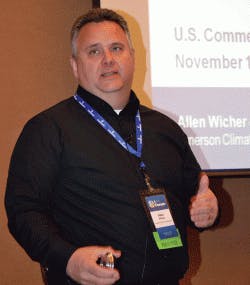Emerson ‘E360 Forum’ Looks Into 'The Future of Refrigeration'
Emerson Climate Technologies held its first ‘E360 Forum’ in Columbus, OH on November 13. Judging by the quantity and quality of the contractors in attendance, it was a successful first event. Emerson initiated the E360 Forums as a way to bring current information to food service and food retail-based contractors in different regions, who have many questions about the changing refrigeration/refrigerant/energy landscape.
“The biggest takeaway of this event is that it signals Emerson’s outreach across the country,” said John Rhodes, Emerson’s president of refrigeration. “We’ve always had a great connection to many industries, associations, and educational services. That’s not new. And we’ve had webinar series over the past couple of years. However, this is the first time we’re bringing together multiple parties across the channel,” Rhodes explained. “We’re facing dramatic change in next two to three years. You can no longer be the best system provider without understanding all the changes across each of these variables and components. And, you can no longer be the best component provider without knowing the requirements in all the different systems.
“That’s the genesis of bringing the industry together to collaborate on this depending on the different requirements and finding the best decision for each circumstance.”
Contractor attendees were most concerned about how refrigerant changes will affect system design.
Robin Ashton, president/publisher of Foodservice Equipment Reports, provided an insightful drill-down into the growth of of major refrigeration equipment segments, and the reasons behind that growth. Based on his presentation, which provide a look at the fragmentation at work in the foodservice industry, it was clear to see how significant changes in refrigerant and efficiency policies can and will cause ripple effects across the nation.
“The foodservice market in the U.S. is huge, complex, diverse, and relatively mature,” Ashton said. “At the end-user/operator level, it accounts for more than $700 billion in annual sales. There are 20 different foodservice segments, to go well beyond restaurants, bars and taverns. Just at the purchase level it’s a $250 billion industry, which includes non-foods, chemicals, durable goods and capital goods.”
According to Ashton, more than half of the foodservice market is at the restaurant level, split between full-service and limited service establishments. The so-called non-commercial markets (health care, college/university, primary and secondary schools, lodging) are also significant markets.
Rajan Rajendran, Emerson’s vice president of system innovation and sustainability, and the recently named director of Emerson Innovation Center now under construction, provided an in-depth update on refrigerant regulations and their impact on contractors.
Rajendran provided a brief history of refrigerant evolution, initially introduced by the Montreal Protocol to lower global warming potential (GWP) with the phase-down of HFC-based refrigerants, and most recently driven by the European Union’s and the Environmental Protection Agency’s (EPA) motions to restrict GWP in refrigerants even further. In particular, the EPA will create a new ruling in 2015 as a part of its significant new alternatives proposal (SNAP) to delist some of the most common refrigerants in use today.
Rajendran indicated that R404A will likely be delisted, and described the impact the delisting will have on equipment design.
“Which refrigerant will the industry use as a replacement?” he asked. The answer: while there is no one-size-fits all solution, the re-emergence of CO2, propane and other natural refrigerants, and the introduction of synthetic blends with similar pressure characteristics provide the hope for minimal system redesigns. Attendees were most concerned about the potential impacts to system design.
Other presenters included:
• Mitch Knapke, director, food retail marketing, on trends in refrigerant system architecture and CO2
• André Patenaude, director of CO2 business development
• John Wallace, director of innovation, on how to improve energy efficiency and reduce maintenance.
“My key message was how to effectively use energy management systems that in most cases are already installed in a retail facility, to save energy and save on maintenance,” Wallace said. “I tried to cover a few areas that don’t require a lot of extra effort or cost; just taking advantage of what’s already there.” He also emphasized the importance of data offered by those energy management systems. Many people think the management systems are there to provide control; that’s correct, but they also provide valuable data you can use to take an analytical look and conduct proactive maintenance.”
• Allan Wicher, director, foodservice and Ani Jayanth, foodservice marketing manager on how to meet 2015-2017 energy and refrigerant regulations.
Wicher pulled no punches in describing the impact the EPA’s refrigerant phaseouts will have on the commercial foodservice industry.
“The typical 5,000 sq.ft. convenience store spends $62,000 per year on energy and maintenance. Store owners and contractors have to:
• Reduce energy consumption with optimized refrigeration equipment system performance
•ensure EPA compliance and reduce GWP with refrigerant choices that minimize impact to equipment performance
•Preserve reliability serviceability and safety.
• Understand the toxicity, flammability and pressure aimpolcations.
• Estimate total cost of ownership and viability of technoolgoy changes.
“As we look into the Rule 20 proposal, we see it’s disruptive, and nearly impossible. We’ve made our comments known, and as an industry we spoke loud and clear that we can’t tackle this thing. R404, 4R07 and R134 have been serving our business for a long time, and taking those away in a 15-month timeframe is impossible.
“The reality is, in the next five years, R404 is gone, R22 is gone from retrofits, but there are viable solutions. We’re continuing to develop those and reach out to the channels to determine what will suit contractors needs. We want to modify our approach to meet your needs as well.”
Ani Jaynath provided guidance into how to proceed in three refrigeration applications: reach-in self contained, walk-in applications, and ice machines. The next E360 Forum will be offered on February 18, in Anaheim, CA. Visit bit.ly/Emerson360Anaheim
to learn more and to register.



